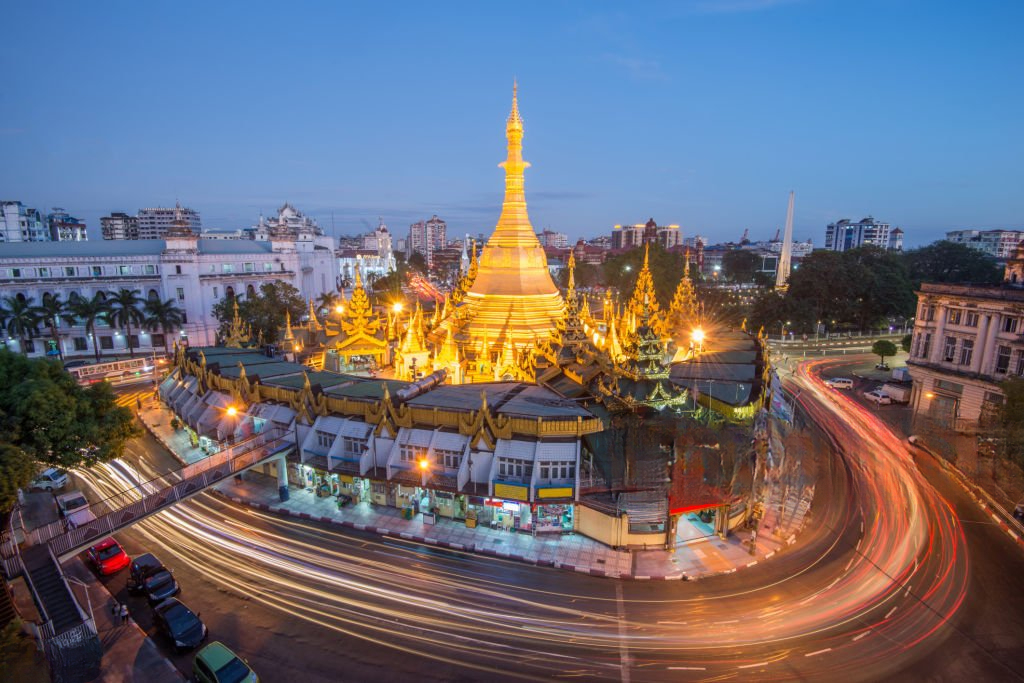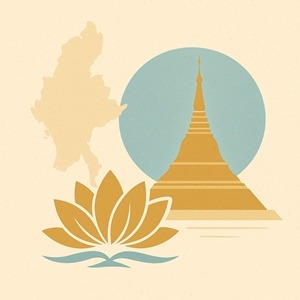
Rising gracefully from the center of downtown Yangon, Sule Pagoda is one of Myanmar’s most iconic landmarks — a golden, ancient stupa that has witnessed centuries of the city’s history.
Located at the busy crossroads of Yangon, the pagoda is not just a religious site, but also a vibrant centerpiece of city life, politics, and culture.
History and Significance
Sule Pagoda is believed to be over 2,600 years old, making it even older than the famous Shwedagon Pagoda.
According to legend, the pagoda enshrines a sacred hair relic of the Buddha, making it a deeply revered site for Buddhists across Myanmar.
Beyond its religious importance, Sule Pagoda has played a key role in Myanmar’s history, serving as a gathering point for major political movements and events.
What to Expect When Visiting
Golden Octagonal Stupa:
Unlike most pagodas, Sule’s stupa is uniquely octagonal, a design preserved throughout its structure from base to tip.Vibrant Local Life:
Surrounding the pagoda, you’ll find bustling markets, colonial-era architecture, tea shops, and busy traffic — offering a true taste of Yangon’s lively spirit.Religious Ceremonies:
Witness local worshippers offering flowers, candles, and prayers. It’s a powerful experience of Myanmar’s deep spiritual traditions.
Visitor Information
📍 Location:
Corner of Sule Pagoda Road and Maha Bandula Road, Downtown Yangon
🕰️ Opening Hours:
Daily from 4:00 AM to 10:00 PM
💵 Entrance Fee:
Approximately 3 USD for foreigners (subject to change)
👗 Dress Code:
Visitors are required to dress modestly — no shorts or sleeveless tops. Shoes must be removed before entering.
Tips for Your Visit
Visit early in the morning or around sunset for the best lighting and a peaceful atmosphere.
Bring a small bag for your shoes, as you’ll need to walk barefoot around the pagoda.
Photography is allowed but be respectful, especially around those who are praying.
Nearby Attractions
City Hall – Beautiful colonial architecture right across the street.
Mahabandula Park – A relaxing green space beside the pagoda.
Bogyoke Aung San Market – Perfect for shopping local crafts and souvenirs.
Experience the Heart of Yangon
A visit to Yangon would not be complete without experiencing the timeless beauty and spiritual energy of Sule Pagoda.
Whether you’re seeking a moment of peace or an authentic slice of Yangon’s vibrant culture, Sule welcomes you.
Frequently Asked Questions about Sule Pagoda
1. Where is Sule Pagoda located?
Sule Pagoda sits in the heart of downtown Yangon, Myanmar, at the junction of Sule Pagoda Road and Mahabandoola Road. It is easily accessible from major landmarks such as City Hall and Independence Monument.
2. How old is Sule Pagoda?
According to local tradition, Sule Pagoda is more than 2,000 years old. It is said to pre-date Shwedagon Pagoda and to enshrine a hair relic of the Buddha.
3. What makes Sule Pagoda unique?
Unlike many ancient stupas built on hills, Sule Pagoda stands at the center of Yangon’s modern grid. Its golden octagonal stupa and circular walkway make it both a spiritual sanctuary and a city landmark.
4. Is Sule Pagoda open to visitors?
Yes. Sule Pagoda welcomes visitors daily, usually from early morning until late evening. Modest dress and removing shoes are required before entering the pagoda grounds.
5. What can travelers see inside Sule Pagoda?
Inside the complex, travelers can explore smaller shrines, Buddha images, astrology posts, and offerings made by local devotees. The peaceful atmosphere contrasts beautifully with Yangon’s busy streets outside.
6. Is there an entrance fee to Sule Pagoda?
A small entrance fee is charged to foreign visitors, while local worshippers usually enter free. Fees help maintain the pagoda and its grounds.
7. What is the best time to visit Sule Pagoda?
The pagoda is most photogenic at sunrise and sunset, when its golden stupa glows warmly under the changing light. Morning visits offer a quieter spiritual experience.
For reservation for your accommodation:



